
As part of my role as Scottish correspondent for Groundtastic magazine I wrote a number of club articles dedicated to a particular stadium. I hugely enjoyed visiting new towns and cities to unearth some architectural gems of the football world. As a roving reporter I visited Tynecastle, Firs Park, Victoria Park, Borough Briggs, and completed a tour of the football grounds of the Highland League to name but a few.
I have recently been watching the vlogs of Footy Adventures, which I would heartily recommend to those of you who are interested in football stadiums and architecture. These vlogs are exactly the sort of thing that I would have been producing if things were different. Sadly, I have been held back by a progressive, genetic disease of the nervous system, the related disability, a lack of technical expertise to produce videos and being in Scotland at the wrong time, with the wrong person.
I suppose what I have done as an alternative is to write Every Silver Lining has a Cloud, which is an autobiographical tour of the Welsh Premier League football grounds. For those who have yet to read it – shame on you. I am happy with my own contribution to the world of football architecture, but I can’t help having feelings of envy and jealousy as I watch the ever increasing body of vlogs produced by Footy Adventures.
I have decided to reproduce the club articles and photographs that I managed to take during my time in Scotland. This was a difficult time for myself as I was beginning to feel the full effects of living with Friedreich’s Ataxia. It would obviously difficult having to rely on trains to get me to my desired destination and the fact that I was losing my dexterity meant that it was increasingly difficult to take decent photographs.
Thankfully, I have managed to find all of my photographs from my travels around the Highland League football grounds way back between the years 2002 – 2006. Much of the information about the grounds will have changed drastically. Indeed, the Highland League itself is now made up of a different line-up of clubs. I believe that this makes the snapshot that I have provided below, even more interesting to football ground enthusiasts. These articles were published in Groundtastic magazine 46-48 during 2006 and I would encourage everyone to subscribe to this excellent production.
Overall, I am happy with my contribution to the magazine, and hope the following is of interest to some of you. The articles appear in their original form, but I have updated some of the archaic website addresses that certain clubs had.
***
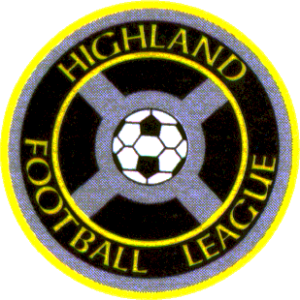
In 1909, Buckie Thistle became the first club east of Elgin to be admitted into the Highland League. Since then, the league has continued to expand eastwards. In the second of a three-part article, we focus on five clubs and grounds that pushed the parameters of the league across Moray and into Aberdeenshire.
Victoria Park – Buckie Thistle
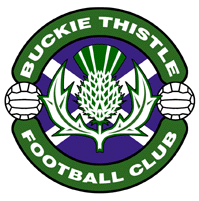
Buckie Thistle were founded in 1889. Their first home grounds were Cluny Park (now Linzee Gordon Park) and Hector’s Park, with the club’s first pavilion being built on the latter property, which became their home ground, until the outbreak of the Great War.
In 1920, the club secured a lease on their present ground, Victoria Park. This venue is in line with the majority of Highland League grounds – two covered stands running along both sides of the pitch with uncovered pathways behind each goal.

The Main Stand dates from 1920, took 13 weeks to build and has remained the club’s grandstand until the present day – although it has undergone a variety of cosmetic changes to its external appearance. The stand is set back from the pitch. Supporters sitting on the wooden benches inside the stand are subsequently quite some distance from the pitch. This structure is only accessible by a wooden staircase. In front of the stand is a raised terrace area that offers no shelter.

To the right of the Main Stand is the Victoria Park Function Hall, which is available to rent out for business functions and private parties through the week and acts as a social club on match days. The Hall was only opened in 2004, boasts catering facilities, plasma TV and recently won an award for its facilities for the disabled.

Opposite the Main Stand is a covered terrace area known as the Shed. A structure was originally completed here in 1953 after a fundraising campaign by supporters but in 1989 this was torn down and replaced by a more modern version to mark the club’s centenary. A plaque recording the generosity of the supporters who helped pay for the Shed is all that remains of the original.
The current ground capacity is 5,400 although on 01/03/58 a record attendance of 8,168 squeezed into Victoria Park to watch a Scottish Cup tie v holders Falkirk.
For more information on Buckie Thistle FC, click here.
Kynoch Park – Keith

Keith FC was formed in 1919. The club first played at Seafield Park before Sir John Kynoch donated Kynoch Park in 1922, which has been home ever since. The current capacity of the ground is 4,500 but on 4th February 1928 a 2nd Round Scottish Cup tie against Celtic attracted 5,820 fans. This remains the record attendance.
Kynoch Park is not a nice place although my opinion has probably been shaped by the fact that I got caught in heavy rain during my visit and had to leave the game just after half-time as there is no shelter at the ground for wheelchair users.
Those standing behind the goals are forced to stand on muddy banks without any protection from the elements. This may be an ideal environment for the grazing cows that populate the adjacent field but it’s not exactly perfect conditions for watching the beautiful (sic) game.
On one side of the pitch stands a covered terrace, where the away fans congregate but alas I could not access it. To reach this corrugated iron shelter you are forced to wade through a muddy embankment, which is not the ideal surface through which to manoeuvre a wheelchair. I wouldn’t choose to watch from this stand anyway as the view is obstructed by several supporting pillars running across the front of the terrace.

Opposite this, is a grandstand, which seats 450 people and was constructed in 1962. However, this is one of those stands – much loved in the Highland League – where you have to scale a flight of steps to reach the seats. This is because the base of the stands houses the changing rooms and offices. The stand is positioned quite a distance from the pitch, which contributes to the wide-open feel of the ground.

The toilets at Kynoch Park are housed in a dodgy looking portakabin, which is also inaccessible. Basically, I had to tie a knot in it.
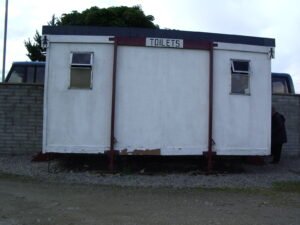
On the plus side, improvements to this shabby ground are being made. As reported in GT 43 the changing rooms have received a total make-over, the dugouts have been replaced with Perspex structures while the Pie Shop has also been refurbished. The transformation continued with drainage of the playing surface and the application of a special fertilizer while the club also paid £2000 for 300 sky blue seats from Coventry City’s old Highfield Road stadium.
In addition to all of this Kynoch Park now boasts a new sponsors lounge, an extended boardroom and a new referee’s room with showers. The ambitious Highlanders are also planning future ground developments including the installation of a new toilet block for supporters, facilities for the disabled and the replacement of safety barriers around the perimeter of the pitch.
For more information on Keith FC, click here.
Christie Park – Huntly

Huntly first used a pitch at Market Muir along with two other clubs – Gordons and Rover. All three clubs eventually merged to become Huntly United circa 1909. The ‘United’ was dropped from the name following the First World War.
As they were unable to charge admittance to the Market Muir ground they moved to Strathbogie Park in 1921. Five years later, Provost Christie announced that he had acquired the ground and he proposed to hand it over to the club on the condition that the club should be continued as an amateur one. It was subsequently decided to rename Strathbogie Park after the generous Provost.
Christie Park was closed down in 1975 after a supporter attacked a referee following a game between Huntly and Rothes. After the final whistle Huntly defender Ian Chalmers was summoned back by the referee. The player had already received a booking and was in the process of being sent off. Spectators making their way across the pitch to the exits surrounded this incident and suddenly the referee fell flat on his face. Mr Macrae’s report stated he’d been struck on the head and became unconscious. The situation was made worse from the SFA perspective as Huntly hadn’t arranged for police to be in attendance for the game. Subsequently, on December 18, 1975, the Referee’s Committee ordered Christie Park to be closed for the first two months of 1976. The club were fined £100 and ordered to have officers on duty at all future home games. Ian Chalmers was suspended for six weeks. Both Elgin and Keith offered Huntly the use of their ground free of charge for ‘home’ games. Although the closure was thought to have cost the club in the region of £1000 they managed to survive.

Today, Christie Park (capacity 4,500) is home to a 270-seat, top-level stand that straddles the halfway line. The changing rooms are housed underneath the stand.

To the left of the stand is an uncovered ‘disabled area’. This merely consists of some disabled logos daubed on the concrete in yellow paint. It is basically just a parking space for people in wheelchairs.

Opposite the Main Stand is a standard covered terrace.

The areas behind both goals are heavily sanded and exposed to the elements.
For more information on Huntly FC, click here.
Harlaw Park – Inverurie Loco Works
 Information on the history of Inverurie Loco Works FC and Harlaw Park is rather difficult to come across after documents recording the clubs history were stolen during a break in and subsequently destroyed. What we do know for sure is that the club were formed in 1903 and played in the Junior ranks until 2002 when they joined the Highland League following the departure of Elgin City and Peterhead to the Scottish League in 2000. This took the league’s membership to 15 clubs, with which it continues to operate.
Information on the history of Inverurie Loco Works FC and Harlaw Park is rather difficult to come across after documents recording the clubs history were stolen during a break in and subsequently destroyed. What we do know for sure is that the club were formed in 1903 and played in the Junior ranks until 2002 when they joined the Highland League following the departure of Elgin City and Peterhead to the Scottish League in 2000. This took the league’s membership to 15 clubs, with which it continues to operate.
Harlaw Park is a typical Highland League ground. Two small stands are positioned on either side of the pitch while supporters who like to stand behind the goals are forced to stand on an uncovered rudimentary path. The capacity at Harlaw Park is 2,500.
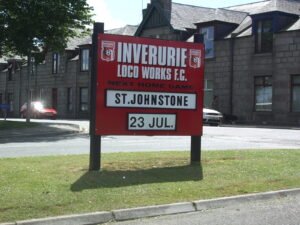
The wooden Main Stand is fitted with benches and is covered. It is flanked by sterile, perspex dugouts.

A slightly larger covered terrace runs opposite with several support beams running along the front of the stand, obstructing the view. This stand was constructed in 2002 before the club made their Highland League debut. Four floodlights – basic poles with three lamps each – are positioned behind the stand. This is mirrored opposite.

The overall impression of a neat ground has been ruined somewhat by the construction of a concrete batching plant immediately behind one of the uncovered ends of the ground. This imposing sight is still to be completed as it needs to be enclosed to reduce dust emission.
There is also a covered enclosure from which disabled fans can watch the game without exposure to the elements.

For more information on Inverurie Loco Works FC, click here.
Princess Royal Park – Deveronvale

Deveronvale were formed in 1938. The name comes from the River Deveron and was chosen to avoid division by reflecting the fact that the club belonged to the twin towns of Banff and Macduff, rather than to either.
Support grew for the new team to play in the Highland League – the only problem was the venue. The late Duke of Fife had gifted Princess Royal Park for local recreation but there was no enclosed part of it which would pass SFA scrutiny. An approach was made to the Duff House Trust – which comprised councillors from both towns – and the trust agreed to give part of the park for senior football and to pay £345 to have the relevant part fenced.
Princess Royal Park (capacity 2,651) sounds grander than it actually is. The ground boasts an impressive Main Stand but the three other sides are flat grassy areas, which gives the ground a neat but sparse and wide-open feel. An enclosure is needed to protect supporters from the elements as unless you are sitting in the stand an umbrella and wellies are needed.

The Main Stand boasts impressive facilities such as changing rooms, refreshment bar, boardrooms, offices and toilets. The wooden home and away dugouts are positioned in front of the stand.

There is also a small hut for disabled supporters to watch the match from – much like the structure at Inverurie. There are four floodlights, two on either side of the pitch, each with 5 lamps on.
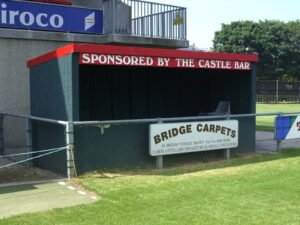
The Temple of Venus, which stands high on top of Doune Hill between Banff and Macduff, is clearly visible from the ground. The temple was built for the Earl of Fife in the 1700’s to improve the skyline and once housed a statue of the goddess Venus.
For more information on Deveronvale FC, click here.
***
For more information on the Highland League, click here.
Highland Hundred by Bill McAllister is the source of much of the information used in this article.

